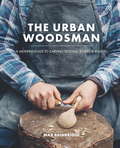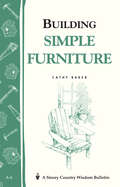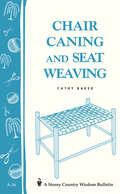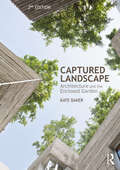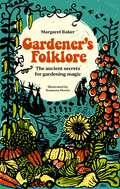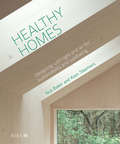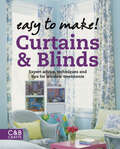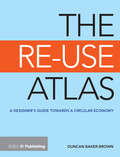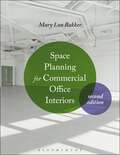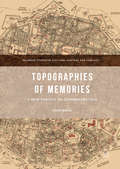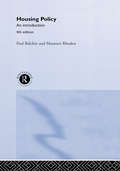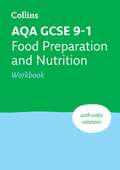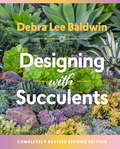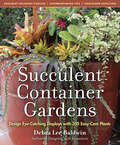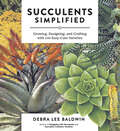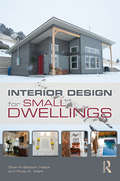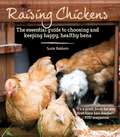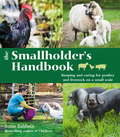- Table View
- List View
The Urban Woodsman
by Max BainbridgeHand carving is easy, satisfying and therapeutic when guided by Max Bainbridge. Create your own unique pieces and carve with confidence thanks to detailed information on tools, cutting techniques and clear step-by-step photography accompanying each project. Start with basic spoons, cooking spoons and spatulas, before moving onto butter knives, chopping boards and small bowls, with only a few simple tools required. Max also advises on the perfect finish for your projects - how to sand, ebonise, scorch and texture surfaces as well as waxing and oiling your new creations. Whether you are a novice or an experienced carver, this book will inspire you to make something that you will be proud of.
Building Simple Furniture: Storey Country Wisdom Bulletin A-06 (Storey Country Wisdom Bulletin)
by Cathy BakerEASY-TO-BUILD PROJECTS FOR THE WEEKEND WOODWORKER!Look over the variety of simple wood-working projects in the bulletin and you’ll quickly find something that deserves a place in your home. A small table for the hallway, perhaps, or an Adirondack chair or picnic set for the deck or garden? The good news is that you don’t need to be a master carpenter with a basement full of power tools to craft these handsome and practical items. With a few simple hand tools and Cathy Baker’s step-by-step instructions and easy-to-follow illustrations and diagrams, you can build sturdy, durable, beautiful wooden furniture that you and your family will enjoy for years to come. Projects include:· Wall shelf· Small bench· Picnic table and benches· Adirondack chair· Pump lamp· Step stool· Storage box· Side table
Chair Caning and Seat Weaving: Storey Country Wisdom Bulletin A-16 (Storey Country Wisdom Bulletin)
by Cathy BakerSince 1973, Storey's Country Wisdom Bulletins have offered practical, hands-on instructions designed to help readers master dozens of country living skills quickly and easily. There are now more than 170 titles in this series, and their remarkable popularity reflects the common desire of country and city dwellers alike to cultivate personal independence in everyday life.
Captured Landscape: Architecture and the Enclosed Garden
by Kate BakerThe enclosed garden, or hortus conclusus, is a place where architecture and landscape come together. It has a long and varied history, ranging from the early paradise garden and cloister, the botanic garden and giardini segreto, the kitchen garden and as a stage for social display. The enclosed garden has continued to develop into its many modern forms: the city retreat, the redemptive garden, the deconstructed building. As awareness of climate change becomes increasingly important, the enclosed garden, which can mediate so effectively between interior and exterior, provides opportunities for sustainable design and closer contact with the natural landscape. By its nature it is ambiguous. Is it an outdoor room, or captured landscape; is it architecture or garden? Kate Baker discusses the continuing relevance of the typology of the enclosed garden to contemporary architects by exploring influential historical examples and the concepts they generate, alongside some of the best of contemporary designs – brought to life with vivid photography and detailed drawings – taken primarily from Britain, the Mediterranean, Japan and North and South America. She argues that understanding the potential of the enclosed garden requires us to think of it as both a design and an experience. Captured Landscape provides a broad range of information and design possibilities for students of architectural and landscape design, practising architects, landscape designers and horticulturalists and will also appeal to a wider audience of all those who are interested in garden design. This second edition of Captured Landscape is enriched with new case studies throughout the book. The scope has now been broadened to include an entirely new chapter concerning the urban condition, with detailed discussions on issues of ecology, sustainability, economy of means, well-being and the social pressures of contemporary city life.
Captured Landscape: Architecture and the Enclosed Garden
by Kate BakerThe enclosed garden, or hortus conclusus, is a place where architecture and landscape come together. It has a long and varied history, ranging from the early paradise garden and cloister, the botanic garden and giardini segreto, the kitchen garden and as a stage for social display. The enclosed garden has continued to develop into its many modern forms: the city retreat, the redemptive garden, the deconstructed building. As awareness of climate change becomes increasingly important, the enclosed garden, which can mediate so effectively between interior and exterior, provides opportunities for sustainable design and closer contact with the natural landscape. By its nature it is ambiguous. Is it an outdoor room, or captured landscape; is it architecture or garden? Kate Baker discusses the continuing relevance of the typology of the enclosed garden to contemporary architects by exploring influential historical examples and the concepts they generate, alongside some of the best of contemporary designs – brought to life with vivid photography and detailed drawings – taken primarily from Britain, the Mediterranean, Japan and North and South America. She argues that understanding the potential of the enclosed garden requires us to think of it as both a design and an experience. Captured Landscape provides a broad range of information and design possibilities for students of architectural and landscape design, practising architects, landscape designers and horticulturalists and will also appeal to a wider audience of all those who are interested in garden design. This second edition of Captured Landscape is enriched with new case studies throughout the book. The scope has now been broadened to include an entirely new chapter concerning the urban condition, with detailed discussions on issues of ecology, sustainability, economy of means, well-being and the social pressures of contemporary city life.
Gardener's Folklore: The ancient secrets for gardening magic
by Margaret BakerEver wondered if there's any truth behind planting by the moon? Or why wassailing is still a common folk practice in some parts of the world? In Gardener's Folklore, the record of these practices is unveiled, with plenty of tips and tricks to try in your own 21st century garden for blooming bushes and plentiful potatoes.First published in 1976, Gardener's Folklore collects the little bits of magic and myth to be found in the gardens of Britain and North America. Compiled from letters sent by gardeners to the author Margaret Baker, it unravels and documents the mysterious sayings and scraps of knowledge that are passed down through generations, while exploring the science of the time that backed up - or in some cases, didn't - the claims that were made.This delightfully written book shows just what people have believed and still believe will help their plants to grow. The observance of lunar and astrological conditions when planting, ways of encouraging fruit-bearing and discouraging pests, beliefs about the effects of climate and calendar, spells, the influence for good and bad of certain plants, the links between owners and trees - these are only a few of the aspects of gardening lore that are discussed.Gleaned from the people who grew up with them, they have much to say about our rural origins as well as having, here and there, implications for our future. Capturing the knowledge that old-time gardeners used to have remarkable successes, the ancient secrets of a happy healthy garden are shared for a new generation of green-fingered plant-lovers.
Healthy Homes: Designing with light and air for sustainability and wellbeing
by Nick Baker Koen SteemersIt is widely acknowledged that there is an urgent need to transform our housing stock to a better energy performance level. However, improving energy performance should not result in a negative impact on the health, wellbeing and the comfort of building occupants. There are many energy-neutral features that can be incorporated at small or zero cost which have a positive effect on wellbeing. This book aims to outline and discuss these aspects of building design. The issue of health and wellbeing has already entered into design advice for the workplace, where productivity and absenteeism are often used as indicators. This book concentrates on residential buildings, notably mass housing and affordable strategies, for which new, more socially and health-oriented indicators are being developed. Provides practical design guidance based on scientific evidence Explores both physical and psychological wellbeing Focuses on the home and immediate domestic environment Structured in an accessible way for architects and designers.
Healthy Homes: Designing with light and air for sustainability and wellbeing
by Nick Baker Koen SteemersIt is widely acknowledged that there is an urgent need to transform our housing stock to a better energy performance level. However, improving energy performance should not result in a negative impact on the health, wellbeing and the comfort of building occupants. There are many energy-neutral features that can be incorporated at small or zero cost which have a positive effect on wellbeing. This book aims to outline and discuss these aspects of building design. The issue of health and wellbeing has already entered into design advice for the workplace, where productivity and absenteeism are often used as indicators. This book concentrates on residential buildings, notably mass housing and affordable strategies, for which new, more socially and health-oriented indicators are being developed. Provides practical design guidance based on scientific evidence Explores both physical and psychological wellbeing Focuses on the home and immediate domestic environment Structured in an accessible way for architects and designers.
Easy to Make! Curtains & Blinds: Expert Advice, Techniques And Tips For Sewers
by Wendy BakerMaking curtains needn’t be left to the professionals – with Easy to Make! Curtains & Blinds you, too, can create stylish window dressings for your home.
The Re-Use Atlas: A Designer's Guide Towards the Circular Economy
by Duncan Baker-BrownThis book is a highly illustrated “map,” using photos, infographics and statistics, showing designers how they can successfully navigate the emerging field of resource management and the circular economy. Using the Brighton Waste House Project as a basis for this, the book will look at key moments and landmark decisions made during its design and construction, as well as the people and projects from around the world that inspired them.
The Re-Use Atlas: A Designer's Guide Towards the Circular Economy
by Duncan Baker-BrownThis book is a highly illustrated “map,” using photos, infographics and statistics, showing designers how they can successfully navigate the emerging field of resource management and the circular economy. Using the Brighton Waste House Project as a basis for this, the book will look at key moments and landmark decisions made during its design and construction, as well as the people and projects from around the world that inspired them.
Space Planning for Commercial Office Interiors
by Mary Lou BakkerSpace Planning for Commercial Office Interiors, 2nd Edition, provides a thorough and engaging look at the entire process of space planning, from meeting the client for the first time to delivering a beautifully rendered and creative space plan that addresses all of that client's needs. The author takes readers through a step-by-step method that includes establishing client requirements, developing and translating ideas into design concepts, drafting layouts, and ultimately combining these layouts into well-organized, effective floor plans replete with offices, workstations, support rooms, and reception areas. Covering issues such as circulation, spatial and square footage calculations, building codes, adaptation to exterior architecture, ceiling systems, barrier-free designs, and LEED requirements along the way, the text presents all of the key principles, processes, and tasks associated with laying out interior space to optimize the health, safety, and wellness of its occupants. Thoughtfully organized, with useful exercises to help the reader master the entire process and lessons that can be applied to all types of designed interiors, this book is an indispensable learning tool for intermediate-level students in interior design, architecture, facilities management, and construction management as well as professional designers and office managers anticipating a corporate move. This second edition includes a more thorough look at programming and the steps involved, as well as expanded end-of-chapter exercises that focus on initial research.
Topographies of Memories: A New Poetics of Commemoration
by Anita BakshiThis book explores new approaches towards developing memorial and heritage sites, moving beyond the critique of existing practices that have been the traditional focus of studies of commemoration. Offering understandings of the effects of conflict on memories of place, as manifested in everyday lives and official histories, it explores the formation of urban identities and constructed images of the city. Topographies of Memories suggests interdisciplinary approaches for creating commemorative sites with shared stakes. The first part of the book focuses on memory dynamics, the second on Nicosia, the divided capital of Cyprus, and the third on physical and material world interventions. Design practices and modes of engagement with places of memory are explored, making connections between theoretical explorations of memory and forgetting and practical strategies for designers and practitioners.
Topographies of Memories: A New Poetics of Commemoration
by Anita BakshiThis book explores new approaches towards developing memorial and heritage sites, moving beyond the critique of existing practices that have been the traditional focus of studies of commemoration. Offering understandings of the effects of conflict on memories of place, as manifested in everyday lives and official histories, it explores the formation of urban identities and constructed images of the city. Topographies of Memories suggests interdisciplinary approaches for creating commemorative sites with shared stakes. The first part of the book focuses on memory dynamics, the second on Nicosia, the divided capital of Cyprus, and the third on physical and material world interventions. Design practices and modes of engagement with places of memory are explored, making connections between theoretical explorations of memory and forgetting and practical strategies for designers and practitioners.
Housing Policy In The United States: An Introduction
by Paul Balchin Maureen RhodenHousing Policy in the United States is an essential guidebook to, and textbook for, housing policy, it is written for students, practitioners, government officials, real estate developers, and policy analysts. It discusses the most important issues in the field, introduces key concepts and institutions, and examines the most important programs. Written as an introductory text, it explains all concepts, trends, and programs without jargon, and includes empirical data concerning program evaluations, government documents, and studies carried out by the author and other scholars. The first chapters present the context surrounding US housing policy, including basic trends and problems, the housing finance system, and the role of the federal tax system in subsidizing homeowner and rental housing. The middle chapters focus on individual subsidy programs. The closing chapters discuss issues and programs that do not necessarily involve subsidies, including homeownership, mixed-income housing, and governmental efforts to improve access to housing by reducing discriminatory barriers in the housing and mortgage markets. The concluding chapter also offers reflections on future directions of US. housing policy.
Housing Policy In The United States: An Introduction
by Paul Balchin Maureen RhodenHousing Policy in the United States is an essential guidebook to, and textbook for, housing policy, it is written for students, practitioners, government officials, real estate developers, and policy analysts. It discusses the most important issues in the field, introduces key concepts and institutions, and examines the most important programs. Written as an introductory text, it explains all concepts, trends, and programs without jargon, and includes empirical data concerning program evaluations, government documents, and studies carried out by the author and other scholars. The first chapters present the context surrounding US housing policy, including basic trends and problems, the housing finance system, and the role of the federal tax system in subsidizing homeowner and rental housing. The middle chapters focus on individual subsidy programs. The closing chapters discuss issues and programs that do not necessarily involve subsidies, including homeownership, mixed-income housing, and governmental efforts to improve access to housing by reducing discriminatory barriers in the housing and mortgage markets. The concluding chapter also offers reflections on future directions of US. housing policy.
Collins GCSE Grade 9-1 Revision — AQA GCSE 9-1 FOOD PREPARATION & NUTRITION WORKBOOK: Ideal For Home Learning, 2023 And 2024 Exams
by Fiona Balding Kath Callaghan Suzanne Gray Barbara Monks Barbara Rathmill Louise T Davies Collins GcseDesigning with Succulents: Growing, Designing, And Crafting With 100 Easy-care Varieties
by Debra Lee BaldwinWith updated plant lists, new photography, and beautiful featured gardens, this 10th anniversary edition of Designing with Succulents is essential for anyone who wants to create a lush garden of waterwise plants.
Succulent Container Gardens: Design Eye-Catching Displays with 350 Easy-Care Plants
by Debra Lee BaldwinWhether your goal is a gorgeous potted garden for a sunny windowsill or outdoor living area—or simply making great gifts—this is a comprehensive primer using succulents to create vibrant, living works of art.
Succulents Simplified: Growing, Designing, and Crafting with 100 Easy-Care Varieties
by Debra Lee BaldwinSucculents Simplified is a complete primer on choosing, growing and designing with succulents.
Interior Design for Small Dwellings
by Sherrill Baldwin Halbe Rose K MarkInterior Design for Small Dwellings addresses the onrush of interest in smaller homes and the possibility that small dwellings might be the answer to housing needs and sustainability. The book explores key principles essential to residing and designing small interiors with emphasis on client involvement and implementation of participatory, inclusive design as advocated by the Council for Interior Design Accreditation. Does living in a small space mean living small? The authors believe that by simplifying one’s life intelligently and applying certain principles of design, planning and organization, one can actually live a meaningful life in a smaller space. These tenets are based on the authors’ professional experiences and living in small homes. To this end, the book provides discussion, images, case studies, interviews, worksheets, activities and suggested explorations. Interior Design for Small Dwellings is a teaching guide and provides information and exercises that help professional designers utilize design theory, space planning and programming techniques. Throughout, the text affords sustainability, biophilic design and wellness methodologies.
Interior Design for Small Dwellings
by Sherrill Baldwin Halbe Rose K MarkInterior Design for Small Dwellings addresses the onrush of interest in smaller homes and the possibility that small dwellings might be the answer to housing needs and sustainability. The book explores key principles essential to residing and designing small interiors with emphasis on client involvement and implementation of participatory, inclusive design as advocated by the Council for Interior Design Accreditation. Does living in a small space mean living small? The authors believe that by simplifying one’s life intelligently and applying certain principles of design, planning and organization, one can actually live a meaningful life in a smaller space. These tenets are based on the authors’ professional experiences and living in small homes. To this end, the book provides discussion, images, case studies, interviews, worksheets, activities and suggested explorations. Interior Design for Small Dwellings is a teaching guide and provides information and exercises that help professional designers utilize design theory, space planning and programming techniques. Throughout, the text affords sustainability, biophilic design and wellness methodologies.
Chickens: The Essential Guide To Choosing And Keeping Happy, Healthy Hens (Gardening Ser.)
by Suzie BaldwinKeeping chickens is fun, relaxing, and low maintenance, plus you have the added benefit of your own known source of fresh eggs. In Chickens, poultry breeders Graham Page and Suzie Baldwin offer a practical guide to everything the beginner needs to know, from whether to buy chicks or hens, what varieties to chose, how to tell if you're buying a healthy chicken and how to ensure it stays that way, to how many chickens you should keep, and what kind of coop to buy. They also answer all the questions commonly posed by first-time owners, from whether chickens ever fly away and how quickly they will start laying, to how to prevent them being attacked by foxes and what to do when they become unwell.
The Smallholder's Handbook: Keeping And Caring For Poultry And Livestock On A Small Scale
by Suzie BaldwinThe Smallholder's Handbook is a detailed manual to start, plan and manage your own smallholding. Suzie explains the level of work involved, how much space you need and how to prepare your land. There are chapters on keeping poultry (chickens, turkeys, ducks and geese), as well as pigs, goats and sheep, cows and bees. She also explains why having a variety of animals makes the best use of your resources and how many of each type to keep. Comprehensive advice includes choosing breeds, transporting, feeding, housing, daily care and wellbeing, as well as international legislation that applies to livestock.
Professionalism in the Built Heritage Sector: Edited Contributions to the International Conference on Professionalism in the Built Heritage Sector, February 5-8, 2018, Arenberg Castle, Leuven, Belgium
by Koen Van Balen Aziliz VandesandeProfessionalism entails the conduct, aims and qualities that characterise a profession. The term is also used to describe education and training standards for the knowledge and skills necessary to perform a specific profession. In practice, professional standards of practice and ethics are agreed upon and maintained by recognised associations. In the past, professionalism has not occupied a central place in built heritage discussions, policy and research. Recent changes in terms of public attitudes and sustainability concerns have had a cumulative impact on the requirements for professionalism in the built heritage sector. The future success of the sector will depend on the availability of adequate professionals and an appropriately skilled workforce. In practice, the built heritage sector involves much more than interventions to conserve, preserve, rehabilitate or restore a heritage structure. Bringing a project to fruition begins with the formulation of a policy, proceeds to the design and execution of intervention strategies and ends with ongoing maintenance of heritage structures and related future programming. This process requires sufficient interactions between different professionals to obtain a common vision and hold that vision throughout a project. At the same time, the sustainability of the sector is also defined by effective governance, societal support and cultural rationales. Professionalism in the Built Heritage Sector contains reports on the lectures of the international conference organized by the Raymond Lemaire International Centre for Conservation (Leuven, Belgium, February 5th-8th, 2018). The contributions in this volume meet the increasing demand for shared information to support the transition towards a more sustainable conservation process. The volume consists of three main parts that deal with practice-led research or scientific research: "Profiles and capacities", "Education, training and quality labels", and "Obstacles and changes".
